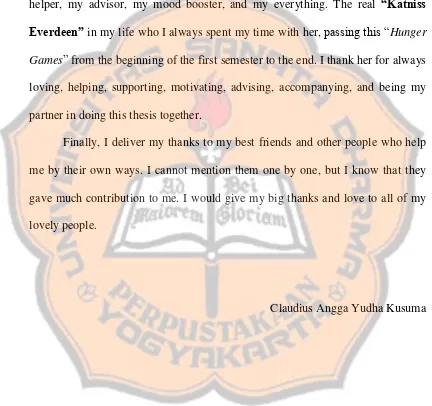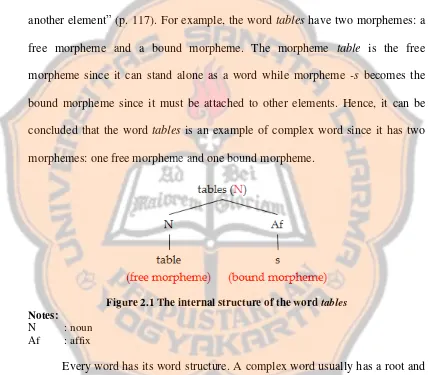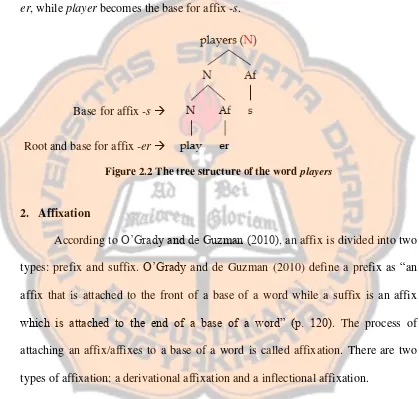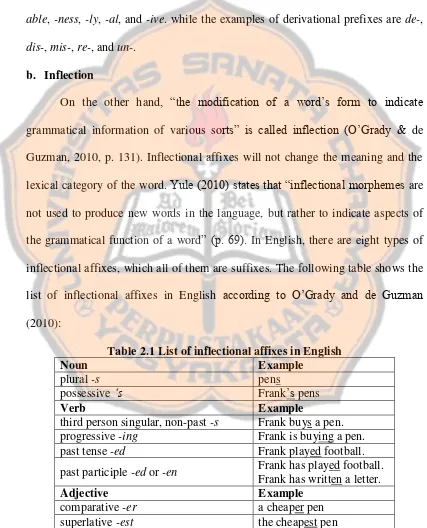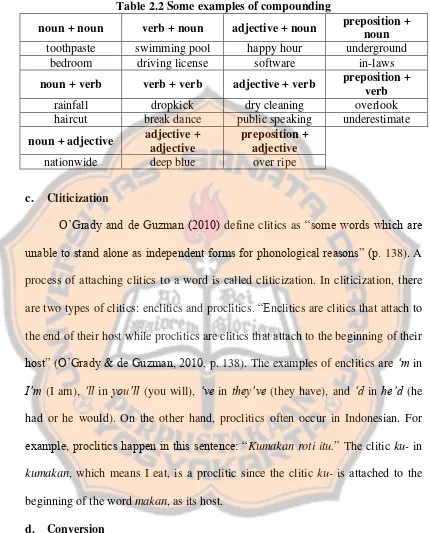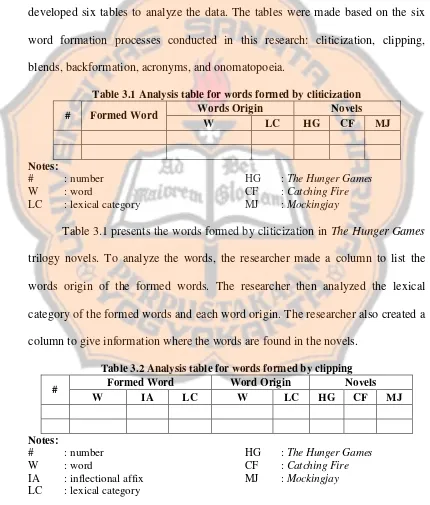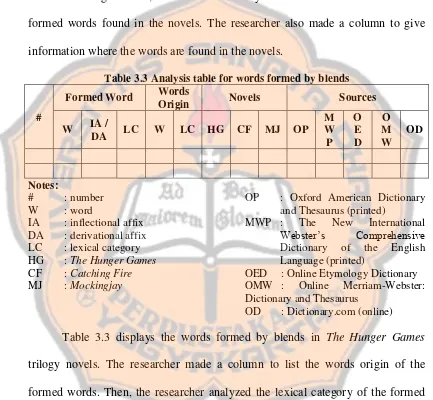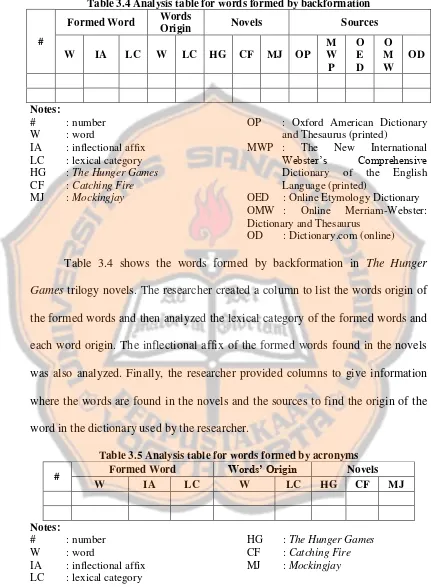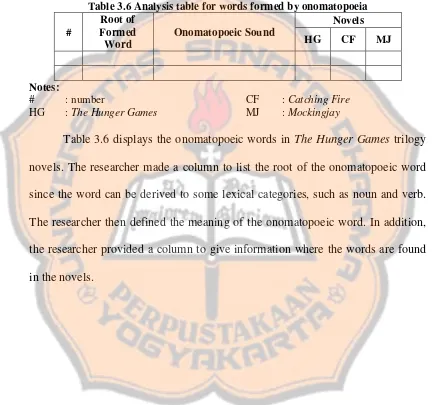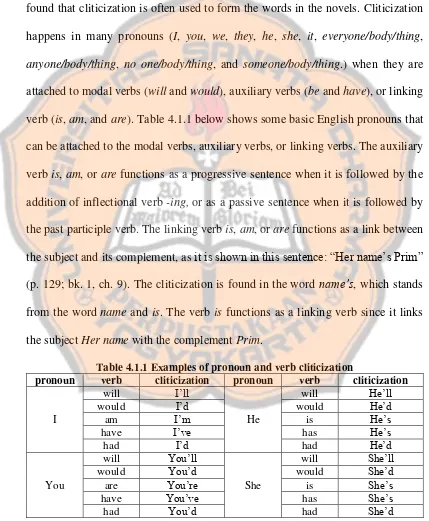MINOR WORD FORMATION PROCESSES IN THE HUNGER GAMES TRILOGY NOVELS
A SARJANA PENDIDIKAN THESIS
Presented as Partial Fulfillment of the Requirements to Obtain the Sarjana Pendidikan Degree
in English Language Education
By
Claudius Angga Yudha Kusuma 131214024
ENGLISH LANGUAGE EDUCATION STUDY PROGRAM DEPARTMENT OF LANGUAGE AND ARTS EDUCATION FACULTY OF TEACHERS TRAINING AND EDUCATION
SANATA DHARMA UNIVERSITY YOGYAKARTA
i
MINOR WORD FORMATION PROCESSES IN THE HUNGER GAMES
TRILOGY NOVELS
A SARJANA PENDIDIKAN THESIS
Presented as Partial Fulfillment of the Requirements to Obtain the Sarjana Pendidikan Degree
in English Language Education
By
Claudius Angga Yudha Kusuma 131214024
ENGLISH LANGUAGE EDUCATION STUDY PROGRAM DEPARTMENT OF LANGUAGE AND ARTS EDUCATION FACULTY OF TEACHERS TRAINING AND EDUCATION
SANATA DHARMA UNIVERSITY YOGYAKARTA
iv
This research is dedicated to my beloved parents, who always love,
vii ABSTRACT
Kusuma, Claudius Angga Yudha. (2017). Minor Word Formation Processes in The Hunger Games Trilogy Novels. Yogyakarta: English Language Education Study Program, Department of Language and Arts Education, Faculty of Teachers Training and Education, Sanata Dharma University.
Humans are creative. Many new words are produced in many languages, such as in English, and the production keeps increasing. Although the words have not been listed in the dictionary yet, humans can still understand the meaning. However, there were many words formed before by using some processes, such as clipping, blends, acronyms, and backformation. Some of the processes are called word formation processes.
Many words formed by using word formation processes are often found in novels, since they have a rich use of words. The examples of the novels are The Hunger Games trilogy novels, written by Suzanne Collins. Therefore, this research aims to answer the research question ―how do the minor word formation processes happen in The Hunger Gamestrilogy novels?‖
Content or document analysis was used as the research method to analyze the data, since this research used The Hunger Games trilogy novels, entitled The Hunger Games, Catching Fire, and Mockingjay, as the sources of data. This research analyzed the six out of seven minor word formation processes classified by O‘Grady and de Guzman (2010): cliticization, clipping, blends, backformation, acronyms, and onomatopoeia. Morphological analysis became the nature of this research since this research dealt with the morphemes in forming words.
The results of this research showed that all six word formation processes proposed were found in the novels. The researcher found 294 lexical items formed by using cliticization, 74 lexical items formed by using onomatopoeia, 30 lexical items formed by using clipping, 20 lexical items formed by using backformation, 15 lexical items formed by using blends, and one lexical item formed by using acronyms. Cliticization was the most frequently used process to form the words while acronyms became the least frequently used process to form the words in the novels.
viii ABSTRAK
Kusuma, Claudius Angga Yudha. (2017). Minor Word Formation Processes in The Hunger Games Trilogy Novels. Yogyakarta: Program Studi Pendidikan Bahasa Inggris, Jurusan Pendidikan Bahasa dan Seni, Fakultas Keguruan dan Ilmu Pendidikan, Universitas Sanata Dharma.
Manusia adalah makhluk yang kreatif. Banyak kata baru diciptakan di berbagai bahasa, seperti Bahasa Inggris, dan hal tersebut terus meningkat. Meskipun kata-kata tersebut belum didefinisikan di kamus, manusia masih dapat memahami makna dari kata tersebut. Bagaimanapun juga, telah ada banyak kata yang diciptakan dengan menggunakan beberapa proses, seperti clipping, blends, acronyms, dan backformation. Beberapa dari proses inilah yang disebut dengan proses pembentukan kata.
Kata-kata yang diciptakan menggunakan proses pembentukan kata sering ditemukan di novel, karena novel memiliki penggunaan kata yang sangat banyak. Sebagai contoh adalah novel trilogi The Hunger Games, yang ditulis oleh Suzanne Collins. Oleh sebab itu, penelitian ini bertujuan untuk menjawab rumusan masalah ―bagaimana proses pembentukan kata minor terjadi di novel trilogi The Hunger Games?‖
Analisis isi digunakan sebagai metode penelitian untuk menganalisis data karena penelitian ini meggunakan novel trilogi The Hunger Games, yang berjudul The Hunger Games, Catching Fire, dan Mockingjay, sebagai sumber data. Penelitian ini menganalisis enam dari tujuh proses minor pembentukan kata yang diklasifikasikan oleh O‘Grady and de Guzman (2010): cliticization, clipping, blends, backformation, acronyms, dan onomatopoeia. Analisis morfologi menjadi dasar dari penelitian ini karena penelitian ini berhubungan dengan morfem dalam membentuk kata.
Hasil dari penelitian ini menunjukkan bahwa enam proses yang dipelajari ditemukan di novel. Peneliti menemukan 294 kata yang dibentuk dengan menggunakan cliticization, 74 kata yang dibentuk dengan menggunakan onomatopoeia, 30 kata dibentuk dengan menggunakan clipping, 20 kata dibentuk dengan menggunakan backformation, 15 kata dibentuk dengan menggunakan blends, dan satu kata dibentuk menggunakan acronyms. Cliticization menjadi proses yang paling sering digunakan untuk membentuk kata sedangkan akronim menjadi proses yang paling jarang digunakan dalam novel ini.
ix
ACKNOWLEDGMENTS
Firstly, I would like to deliver my biggest gratitude to God for all blessings, cleverness, and health that are given to me so that I can struggle to finish my thesis. I would also thank Him as He has given many beloved people who always support me in doing my thesis. I would not be able to finish this thesis without His great blessings and great people in my life.
I thank God as He has given me great parents and families that always love, educate, and support me. I send my big gratitude and love to my father, Yohanes Soeprapto, and my beloved mother, Maria Myjati, who become my motivations and reasons to finish my thesis as I always want to give them happiness. I also want to thank my two younger brothers and all my family members who support me in their own ways.
x
figure of another father in the campus with his patience and kindness. I would also thank to any lecturers who support and guide me in many ways.
I also want to express my big gratitude and love to someone special: my beloved special friend, my partner in crime, my supporter, my motivation, my helper, my advisor, my mood booster, and my everything. The real “Katniss Everdeen” in my life who I always spent my time with her, passing this ―Hunger
Games‖ from the beginning of the first semester to the end. I thank her for always loving, helping, supporting, motivating, advising, accompanying, and being my partner in doing this thesis together.
Finally, I deliver my thanks to my best friends and other people who help me by their own ways. I cannot mention them one by one, but I know that they gave much contribution to me. I would give my big thanks and love to all of my lovely people.
xi
TABLE OF CONTENTS
Page
TITLE PAGE ... i
APPROVAL PAGES ... Error! Bookmark not defined. DEDICATION PAGE ... iv
STATEMENT OF WORK‘S ORIGINALITY ... Error! Bookmark not defined. PERNYATAAN PERSETUJUAN PUBLIKASI ... Error! Bookmark not defined. ABSTRACT ... vii
ABSTRAK ... viii
ACKNOWLEDGMENTS ... ix
TABLE OF CONTENTS ... xi
LIST OF TABLES ... xiv
LIST OF FIGURES ... xvi
LIST OF APPENDICES ... xvii
CHAPTER I. INTRODUCTION ... 1
A. Research Background ... 1
B. Research Question... 4
C. Research Significance ... 4
D. Definition of Terms ... 5
CHAPTER II. REVIEW OF RELATED LITERATURE ... 7
A. Theoretical Description ... 7
1. Words, Morphemes, and Word Structure ... 7
2. Affixation ... 9
a. Derivation ... 9
b. Inflection ... 10
3. Minor Word Formation Processes ... 11
xii
b. Compounding ... 11
c. Cliticization ... 12
d. Conversion ... 12
e. Clipping ... 14
f. Blends ... 14
g. Backformation ... 15
h. Acronyms ... 15
i. Initialisms ... 16
j. Onomatopoeia ... 17
k. Coinage or Word Manufacture or Invention ... 17
l. Eponyms ... 18
m. Internal Change ... 18
n. Suppletion ... 19
o. Reduplication ... 19
B. Theoretical Framework ... 19
CHAPTER III. RESEARCH METHODOLOGY ... 21
A. Research Method... 21
B. Sources of Data ... 22
C. Instruments and Data Gathering Technique ... 22
D. Data Analysis Technique ... 23
CHAPTER IV. RESEARCH RESULTS AND DISCUSSION ... 28
A. Minor Word Formation Processes in The Hunger Games Trilogy Novels ... 28
1. Cliticization ... 29
2. Onomatopoeia ... 32
3. Clipping ... 34
4. Backformation ... 37
5. Blends ... 39
xiii
CHAPTER V. CONCLUSIONS, IMPLICATIONS, AND
RECOMMENDATIONS ... 44
A. Conclusions ... 44
B. Implications ... 46
C. Recommendations ... 46
REFERENCES ... 48
xiv
LIST OF TABLES
Table Page
2.1 List of inflectional affixes in English ... 10
2.2 Some examples of compounding ... 12
3.1 Analysis table for words formed by cliticization ... 24
3.2 Analysis table for words formed by clipping ... 24
3.3 Analysis table for words formed by blends ... 25
3.4 Analysis table for words formed by backformation ... 26
3.5 Analysis table for words formed by acronyms ... 26
3.6 Analysis table for words formed by onomatopoeia ... 27
4.1.1 Examples of pronoun and verb cliticization ... 29
4.1.2 Examples of proper noun and verb cliticization ... 30
4.1.3 Examples of common noun and verb cliticization ... 30
4.1.4 Examples of verb and adverb (not) cliticization ... 31
4.1.5 Examples of modal verb and auxiliary verb (have) cliticization ... 31
4.1.6 Examples of adverb and verb cliticization... 31
4.2.1 Examples of onomatopoeia related to animals‘ sound ... 33
4.2.2 Examples of onomatopoeia related to collision‘ sound ... 33
4.2.3 Examples of onomatopoeia related to liquid‘s sound ... 34
4.3.1 Clipping of name and new lexical items found in the novels ... 35
4.3.2 Examples of common clipped words often found in the novels ... 36
xv
xvi
LIST OF FIGURES
Figure Page
2.1 The internal structure of the word tables ... 8
2.2 The tree structure of the word players ... 9
5.1 The inflectional process of the word electrocuted ... 41
5.2 The derivational process of the word electrocution ... 41
xvii
LIST OF APPENDICES
Appendix Page
1. Summary of The Hunger Games novel ... 52
2. Summary of Catching Fire novel ... 53
3. Summary of Mockingjay novel ... 54
4. List of words formed by cliticization ... 55
5. List of words formed by onomatopoeia ... 69
6. List of words formed by clipping ... 73
7. List of words formed by backformation ... 75
8. List of words formed by blends ... 77
1 CHAPTER I INTRODUCTION
This chapter presents the background information and the rationale of this research. This chapter also formulates the research question that underlies why the researcher conducted this research as well as its benefits. Therefore, this chapter is divided into four sections: (1) the research background, (2) the research question, (3) the research significance, and (4) the definition of terms used in this research.
A. Research Background
Humans are creative. This creativity makes them able to produce many new words in a short time. Recently, in many languages, especially in English, there are many new words produced by humans. The examples of humans‘ creativity can often be found in some novels in the form of new words, which have not been defined in the dictionary yet. Although the words have not been defined yet, humans can still understand the meanings of the words. They understand the meanings of those words by reading the story. After reading the story, humans will recognize the meanings of those words by inferring the context. Aitchison (2003) explains that humans can utter a new word which has never been said before whenever they want; it can still be understood even in the most unlikely circumstances.
flu is formed from influenza, the word brunch is formed from breakfast and lunch, the word PIN is formed from personal identification number, and the word edit is formed from editor. These words are formed by using some processes: clipping, blends, acronyms, and backformation. The processes of forming those words are called word formation processes.
Word formation processes are often found in some novels since they have a rich use of words. The examples of the novels are The Hunger Games trilogy novels, written by Suzanne Collins. They are The Hunger Games, Catching Fire, and Mockingjay. These novels tell a story of Katniss Everdeen who participates in a game called Hunger Games. The game is made as a guarantee to remind the districts about the treason to Capitol so that it does not happen again. Katniss has to struggle in this game for two periods so that she can survive and take revenge on President Snow, the cruel president who rules Panem.
Other Sanata Dharma University students have done recent studies of word formation. However, this research is considered relatively new. To the best of the researcher‘s knowledge, the previous studies do not use the novels as the media.
The recent study conducted by Lakshita (2014) discovered that there were six types out of eight types of word formation processes proposed found in Carter Chambers‘ utterance in The Bucket List movie script. The next study conducted by
Pradana (2013) found that many words in Cockney and Bahasa Binan basically also existed in English and Bahasa Indonesia. Another research by Adyaningtyas (2013) discovered that eight out of eleven word formation processes proposed were found in the Pepsi and Coca-Cola advertisements published in the United States from 1950 until 2012.
Some researchers in other universities also conducted other studies. Two Diponegoro University students conducted the studies. The first study, conducted by Rahmawati (2012), classified some word formation processes on slang words used by transsexual while the second study found that compounding was the process that frequently happened in billboard advertisements in Semarang (Anggraeni, 2011). In addition, Tumiayah (2011), a student from Jember University, found that there were six word-formation processes in the article Are These the Best Years of Your Life?
in word formation processes in scientific English. Finally, the study conducted by Kalima (2007) discovered that acronyms and clipping were the most dominant processes found in internet gaming. Therefore, the researcher wants to conduct a new study from a different angle, by analyzing novels, as the media. However, this research focuses on the linguistic analysis rather than literary analysis. Hence, any intrinsic elements of the novels, such as the characters, the characterizations, and the plot, will not be discussed in this research.
B. Research Question
This research is going to answer one research question. The research question is ―how do the minor word formation processes happen in The Hunger
Games trilogy novels?‖ This research question analyzes the words which are formed by some word formation processes in The Hunger Games trilogy novels, written by Suzanne Collins.
C. Research Significance
The researcher expects that this research will give some benefits to three parties. They are English learners, English lecturers, and other researchers.
1. For English learners
real examples, they may understand it easier. The high popularity of The Hunger Games novels since they were filmed may also motivate English learners, especially teenagers, to learn English morphology interestingly.
2. For English lecturers
For English lecturers, this research can be implemented as an alternative to teach students in a fun and interesting way. Lecturers can teach their students about the implementation of word formation processes examples in the real life. Therefore, the researcher hopes that lecturers can teach and motivate their students in studying morphology.
3. For other researchers
By conducting this research, the researcher expects that this research can be useful for other researchers who are interested in conducting the research in the same field, morphology, focusing on the word formation processes. The researcher hopes that this research can help other researchers to analyze other word formation processes in other novels or documents. In addition, the researcher hopes that this research can link to other linguistic study field, such as analyzing phonetics, phonology, syntax, semantics, or pragmatics.
D. Definition of Terms
1. Word Formation Processes
Word formation processes are the processes of forming some words by adding or removing affixes, which are bound morphemes. There are many word formation processes in the morphology. However, to limit the discussion of this research, the researcher will analyze six out of seven minor word formation processes which are proposed by O‘Grady and de Guzman (2010). The processes are cliticization, conversion, clipping, blends, backformation, acronyms, and onomatopoeia. However, the researcher did not analyze conversion since it has been analyzed in depth in other study (Bram, 2011).
2. The Hunger Games Trilogy
7 CHAPTER II
REVIEW OF RELATED LITERATURE
This chapter presents some related theories which are used to support this research. This chapter is divided into two main sections: (1) the theoretical description and (2) the theoretical framework. The theoretical description aims to review the theories of morphology, including the theories of the word formation processes discussed in this research. The theoretical framework attempts to summarize and relate the theories to this research.
A. Theoretical Description
This section provides the review of the theories which are used by the researcher. This section reviews two main theories. The first main theory deals with morphology, such as words, morphemes, and affixes. The second main theory deals with the word formation processes. It elaborates some examples of word formation processes, such as borrowing, clipping, blends, backformation, and coinage.
1. Words, Morphemes, and Word Structure
O‘Grady and de Guzman (2010) define a word as ―the smallest free form found in language‖ (p. 116). They find that there are two types of words: a simple
O‘Grady and de Guzman (2010) define a morpheme as ―the smallest unit
of language that carries information about meaning or function‖ (p. 117). There are two types of morphemes: a free morpheme and a bound morpheme. According to O‘Grady and de Guzman (2010), ―a free morpheme is a morpheme that can be a word by itself, while a bound morpheme is a morpheme that must be attached to another element‖ (p. 117). For example, the word tables have two morphemes: a free morpheme and a bound morpheme. The morpheme table is the free morpheme since it can stand alone as a word while morpheme -s becomes the bound morpheme since it must be attached to other elements. Hence, it can be concluded that the word tables is an example of complex word since it has two morphemes: one free morpheme and one bound morpheme.
Figure 2.1 The internal structure of the word tables
Notes:
N : noun Af : affix
A word also has a base. O‘Grady and de Guzman (2010) define a base as ―the form to which an affix is added‖ (p. 119). For instance, Figure 2.2 below
shows that the word players consists of two affixes: -er and –s. The free morpheme play becomes the root of the word players and also the base for affix -er, while player becomes the base for affix -s.
Figure 2.2 The tree structure of the word players
2. Affixation
According to O‘Grady and de Guzman (2010), an affix is divided into two types: prefix and suffix. O‘Grady and de Guzman (2010) define a prefix as ―an affix that is attached to the front of a base of a word while a suffix is an affix which is attached to the end of a base of a word‖ (p. 120). The process of
attaching an affix/affixes to a base of a word is called affixation. There are two types of affixation: a derivational affixation and a inflectional affixation.
a. Derivation
According to O‘Grady and de Guzman (2010), ―derivation is an affixational process that forms a word with a meaning and/or category distinct from that of its base‖ (p. 122). As stated by Yule (2010) that ―derivational
morphemes make new words or make words of a different grammatical category Base for affix -s
from the stem‖ (p. 69), in derivation, a word that is attached to an affix will change to another lexical category. Therefore, derivational morphemes will change the meanings of a word. In English, derivational affix can be in a form of a suffix or a prefix. The examples of derivational suffixes are -(at)ion, -ize, -ment, -able, -ness, -ly, -al, and -ive. while the examples of derivational prefixes are de-, dis-, mis-, re-, and un-.
b. Inflection
On the other hand, ―the modification of a word‘s form to indicate grammatical information of various sorts‖ is called inflection (O‘Grady & de Guzman, 2010, p. 131). Inflectional affixes will not change the meaning and the lexical category of the word. Yule (2010) states that ―inflectional morphemes are not used to produce new words in the language, but rather to indicate aspects of the grammatical function of a word‖ (p. 69). In English, there are eight types of inflectional affixes, which all of them are suffixes. The following table shows the list of inflectional affixes in English according to O‘Grady and de Guzman (2010):
Table 2.1 List of inflectional affixes in English
Noun Example
plural -s pens
possessive ‘s Frank‘s pens
Verb Example
third person singular, non-past -s Frank buys a pen. progressive -ing Frank is buying a pen. past tense -ed Frank played football. past participle -ed or -en Frank has played football.
Frank has written a letter.
Adjective Example
comparative -er a cheaper pen
3. Minor Word Formation Processes
A word formation process can be defined as a process which is used to form a word by taking, adding, removing, or even changing the structure of a word/words. There are many processes that can be used to form a word. Below are the explanation of word formation processes, such as borrowing, clipping, conversion, cliticization, and blends.
a. Borrowing
Yule (2010) defines borrowing as ―a process of taking over of words from other languages‖ (p. 54). However, according to Zapata (2007), the language that borrows the terms usually adapts the phonology and morphology of the borrowed words. Hence, borrowed words do not copy the same from their original language. Yule (2010) gives some examples of borrowed words in English, such as ―croissant (French), piano (Italian), pretzel (German), sofa (Arabic), tattoo
(Tahitian), tycoon (Japanese), yogurt (Turkish), and zebra (Bantu)‖ (p. 54). b. Compounding
Table 2.2 Some examples of compounding
noun + noun verb + noun adjective + noun preposition + noun toothpaste swimming pool happy hour underground
bedroom driving license software in-laws noun + verb verb + verb adjective + verb preposition +
verb
rainfall dropkick dry cleaning overlook
haircut break dance public speaking underestimate noun + adjective adjective +
adjective
preposition + adjective nationwide deep blue over ripe
c. Cliticization
O‘Grady and de Guzman (2010) define clitics as ―some words which are unable to stand alone as independent forms for phonological reasons‖ (p. 138). A
process of attaching clitics to a word is called cliticization. In cliticization, there are two types of clitics: enclitics and proclitics. ―Enclitics are clitics that attach to the end of their host while proclitics are clitics that attach to the beginning of their host‖ (O‘Grady & de Guzman, 2010, p. 138). The examples of enclitics are ‘m in I’m (I am), ‘ll in you’ll (you will), ‘ve in they’ve (they have), and ‘d in he’d (he
had or he would). On the other hand, proclitics often occur in Indonesian. For example, proclitics happen in this sentence: ―Kumakan roti itu.‖ The clitic ku- in
kumakan, which means I eat, is a proclitic since the clitic ku- is attached to the beginning of the word makan, as its host.
d. Conversion
O‘Grady and de Guzman (2010) define conversion as a process of
an existing word‘s lexical category and meaning by giving no affix. O‘Grady and de Guzman (2010) explain that ―even though it does not add an affix, conversion is often considered to be a type of derivation because of the change in category and meaning that it brings about‖ (p. 138).
Mela-Athanasopoulou (2009) finds that conversion is mainly divided into two types: clear cases of conversion and marginal cases of conversion. There are three types of clear cases of conversion: verb-to-noun conversions, noun-to-verb conversions, and adjective-to-verb conversions. Some examples of verb-to-noun conversions are drink, catch, cry, and laugh. Next, the examples of noun-to-verb conversions are to bottle, to butter, to salt, and to peel. This type of conversions is the most productive one. Finally, the examples of adjective-to-verb conversions are found in the words to clear, to lower, to black, and to calm.
re’fill. However, in some cases, conversion does not occur in converted deverbal
nouns. For instance, the noun at’tack is formed from verb at’tack. On the other hand, in denominal verbs, stress is neutral, such as in the verb ‘question from noun ‘question.
e. Clipping
O‘Grady and de Guzman (2010) define clipping as a process of deleting
one or more syllables of a polysyllabic word in order to make it short. Clipping is often used to make long word become simpler or shorter. Veisbergs (1999) finds that clipping is often used in noun. However, clipping can also happen in other lexical category, such as verbs and adjectives. The examples are in the verb phone from telephone and in the adjective comfy from comfortable.
Veisbergs (1999) also finds that in English, clipping is commonly found in the school and college slang. Some examples of the words are exam from examination, lab from laboratory, math from mathematics, and dorms from dormitories. Furthermore, O‘Grady and de Guzman (2010) state that clipping is often used in casual speech and in some names. The examples of clipped words in casual speech are flu from influenza and burger from hamburger while some examples of clipped names are Liz, Ron, and Sue.
f. Blends
Liu and Liu (2014) define blends as ―the combination of clipping and compounding in which new words are created by the overlap of words or fragments of existing words‖ (p. 25). In addition, O‘Grady and de Guzman (2010)
existing items, usually the first part of one and the final part of the other‖ (p. 140). The examples of blends are brunch from breakfast and lunch, motel from motor and hotel, and smog from smoke and fog. O‘Grady and de Guzman (2010) also find that crossbred animals are commonly named by using blends. For example, liger or tigon from lion + tiger, zedonk or zonkey from zebra + donkey, and cama from camel + llama. There are some ways to create a blend word. Liu and Liu (2014) classify blends into three types. The first one is head + word. For instance, the word emotag is the blending from the head of the word emotion with complete word tag. The second type is head + tail, as it is found in the word wedsite, the combination of the head of the word wedding and the tail of the word website. The last type is word + tail blending. The example is the word viewser from the head of the word viewer and the tail of the word user.
g. Backformation
According to O‘Grady and de Guzman (2010), a process of removing a
real or supposed affix of a word in order to create a new one is called backformation. Yule (2010) states, ―typically, a word of one type (usually a noun) is reduced to form a word of another type (usually a verb)‖ (pp. 56-57). Some examples of noun to verb backformation are ―donate from donation, resurrect from resurrection, enthuse from enthusiasm, and orient from orientation‖ (O‘Grady & de Guzman, 2010, p. 140)
h. Acronyms
O‘Grady and de Guzman (2010) define acronyms as words which are
word. The same as clipping, acronyms have a function of shortening long words to become a simpler word. Hence, acronyms are often found in our daily life. Izura and Playfoot (2012) state that ―acronyms represent a significant and idiosyncratic part of our everyday vocabulary. The demands of a highly technical society have dramatically increased the proportion of acronyms encountered in everyday language‖ (p. 862).
O‘Grady and de Guzman (2010) explain that acronyms are commonly used
in naming organizations and in military and scientific terminology. Some examples of acronyms are AIDS from Acquired Immune Deficiency Syndrome, PIN from Personal Identification Number, and RAM from Random-Access Memory. However, some words are sometimes not recognized as acronyms. O‘Grady and de Guzman (2010) find three examples of words that actually
acronyms. They are radar from radio detecting and ranging, scuba from self-contained underwater breathing apparatus, and laser from light amplification by stimulated emission of radiation. Pahlavannezhad, Akhlaghi, and Ebrahimi (2012) state that ―this createdword can perform the role of noun in a sentence‖ (p. 168). Long noun phrases consisting more than two words are often shortened by using acronyms as it is showed from the examples.
i. Initialisms
Some examples of initialisms are CD from Compact Disc, VIP from Very Important Person, and COD from Cash on Delivery.
j. Onomatopoeia
O‘Grady and de Guzman (2010) define onomatopoeic words as the words
that are created to represent the name of a thing‘s sound. Onomatopoeic sounds do not show the intrinsic connection between a word and its meaning. Some examples of onomatopoeic words are meow, cock-a-doodle-doo, atchoo, buzz, and boom. Onomatopoeic words may be different from one language to another because the speaker of the language may hear something in a different way. For example, English speakers will say that the sound of a rooster is cock-a-doodle-doo, while Indonesian speakers will say kukuruyuk.
Simpson (2004) classifies onomatopoeia into two forms: a lexical onomatopoeia and a non-lexical onomatopoeia. ―Lexical onomatopoeia draws upon recognized words in the language system, words like thud, crack, slurp, and buzz, whose pronunciation enacts symbolically their referents outside language‖ (Simpson, 2004, p. 67). On the other hand, ―non-lexical onomatopoeia, by contrast, refers to clusters of sound which echo the world in a more unmediated way, without the intercession of linguistic structure‖ (Simpson, 2004, p. 67). k. Coinage or Word Manufacture or Invention
Zapata (2007) defines word coinage (or invention) as ―the process whereby new words are created outright, either deliberately or accidentally, to fit some purpose‖ (p. 10). Coinage is usually used to represent a nonexistent word of an
coinage or word manufacture is commonly found in a name of products or brands. Some examples of coinage are Kodak, Xerox, Nylon, and Dacron.
l. Eponyms
Fromkin, Rodman, and Hyams (2003) define eponyms as ―words derived from proper names and are another of the many creative ways that the vocabulary of a language expands‖ (p. 98). O‘Grady and de Guzman (2010) mention some
words which are the examples of eponyms. For instances, the word Watt from James Watt and Fahrenheit from Gabriel Fahrenheit. Zapata (2007) also adds some examples of eponyms: Ohm from George Simon Ohm, sandwich from the 4th Earl of Sandwich, and Picasso from Pablo Picasso. It can be seen that eponyms are usually used to name a term in science by taking the name of its inventor, such as in the words Watt, Fahrenheit, and Ohm.
m. Internal Change
n. Suppletion
O‘Grady and de Guzman (2010) define suppletion as ―a morphological
process that replaces a morpheme by an entirely different morpheme in order to indicate grammatical contrast‖ (p. 136). The common examples of suppletion in
English are went, as the past form of the verb go, and was and were, as the past form of the verb be. The present forms of the verb be: is, am, and are, are also the examples of suppletion. The word her, as the possessive adjective of pronoun she, and the word better and best, as the comparative and superlative forms of the word good, are also the examples of suppletion.
o. Reduplication
O‘Grady and de Guzman (2010) explain that reduplication is ―a process of
repeating all or part of the base to which it applies to mark a grammatical or semantic contrast‖ (p. 137). Another language, such as Indonesian, has some
words that are formed by reduplication to form plural nouns. The examples are anak-anak (children), buku-buku (books), and kucing-kucing (cats).
B. Theoretical Framework
This section outlines the theories to solve the research question of this research. The research question is ―how do the minor word formation processes happen in The Hunger Games trilogy novels?‖ To answer the research question, the researcher uses the theory proposed by O‘Grady and de Guzman (2010). In the theory, O‘Grady and de Guzman (2010) classify seven minor word formation
21 CHAPTER III
RESEARCH METHODOLOGY
This chapter describes the methodology used by the researcher to conduct this research. This chapter also outlines the method of this research and the technique in gathering and analyzing the data. Therefore, this chapter is divided into four sections: (1) the research method, (2) the sources of data (3) the instruments and data gathering technique, and (4) the data analysis technique.
A. Research Method
the novels, as a part of humans to communicate –expressing idea– by producing written words.
This research aimed to analyze the word formation processes which happen in The Hunger Games trilogy novels. Hence, this research dealt with morphology. Yule (2010) finds that morphology, ―which literally means ―the study of forms,‖ was originally used in biology, but, since the middle of the
nineteenth century, has also been used to describe the type of investigation that analyzes all those basic ―elements‖ used in a language‖ (p. 67). Therefore, it can be concluded that the nature of this research was morphological analysis since it dealt with the morphemes in forming the words.
B. Sources of Data
The researcher used three novels as the main data sources to conduct this research. The first novel is entitled The Hunger Games. The novel was published in 2008 and it has 374 pages. The second novel, which was published in 2009, is entitled Catching Fire and it consists of 391 pages. Finally, the last novel, Mockingjay, was published in 2010 and it consists of 390 pages. Each of the novels has 27 chapters and all of them were published by Scholastic Press in New York.
C. Instruments and Data Gathering Technique
Suzanne Collins, entitled The Hunger Games, Catching Fire, and Mockingjay, were used as the instruments of this research. To gather data, the researcher did some steps. The first one was gathering all three novels, both printed and the e-book ones. After all of the novels were gathered, the researcher then read the novels. The next step was finding some examples of the words which are formed by the word formation processes discussed from any sources, such as in books and the Internet. Then, the researcher found the words in the e-book novels and listed the words based on each process discussed, whether they are used in the novels or not. Before analyzing the examples which were found in the internet, the researcher clarified whether the examples found were reliable or not by checking the etymology of the words in some dictionaries, both online and the printed ones. The researcher used three online dictionaries as the references: Online Etymology Dictionary, Merriam-Webster: Dictionary and Thesaurus, and Dictionary.com. There are also two printed dictionaries used by the researcher: Oxford American Dictionary and Thesaurus (2003) and The New International Webster‘s Comprehensive Dictionary of the English Language (1995). If the etymology of the words shows that the process discussed originates a term, the researcher would consider the examples reliable.
D. Data Analysis Technique
lexical category of the formed word and its word/words origin, and gave the information where the word is written in the novels. The researcher used the classification of minor word formation processes proposed by O‘Grady and de Guzman (2010) as the theories in conducting this research since the theories provide more rigid and complete information than other theories. The researcher developed six tables to analyze the data. The tables were made based on the six word formation processes conducted in this research: cliticization, clipping, blends, backformation, acronyms, and onomatopoeia.
Table 3.1 Analysis table for words formed by cliticization
# Formed Word Words Origin Novels
W LC HG CF MJ
Notes:
# : number W : word
LC : lexical category
HG : The Hunger Games
CF : Catching Fire
MJ : Mockingjay
Table 3.1 presents the words formed by cliticization in The Hunger Games trilogy novels. To analyze the words, the researcher made a column to list the words origin of the formed words. The researcher then analyzed the lexical category of the formed words and each word origin. The researcher also created a column to give information where the words are found in the novels.
Table 3.2 Analysis table for words formed by clipping
# Formed Word Word Origin Novels
W IA LC W LC HG CF MJ
Notes:
# : number W : word
IA : inflectional affix LC : lexical category
HG : The Hunger Games
CF : Catching Fire
Table 3.2 shows the words formed by clipping in The Hunger Games trilogy novels. The researcher gave a column to list the word origin of the formed words. The researcher then analyzed the lexical category of the formed words and each word origin. Next, the researcher analyzed the inflectional affix of the formed words found in the novels. The researcher also made a column to give information where the words are found in the novels.
Table 3.3 Analysis table for words formed by blends
#
Formed Word Words
Origin Novels Sources
W IA /
DA LC W LC HG CF MJ OP
M W P O E D O M W OD Notes:
# : number W : word
IA : inflectional affix DA : derivational affix LC : lexical category
HG : The Hunger Games
CF : Catching Fire
MJ : Mockingjay
OP : Oxford American Dictionary and Thesaurus (printed)
MWP : The New International
Webster‘s Comprehensive
Dictionary of the English Language (printed)
OED : Online Etymology Dictionary OMW : Online Merriam-Webster: Dictionary and Thesaurus
OD : Dictionary.com (online)
Table 3.4 Analysis table for words formed by backformation
#
Formed Word Words
Origin Novels Sources
W IA LC W LC HG CF MJ OP
M W P O E D O M W OD Notes:
# : number W : word
IA : inflectional affix LC : lexical category
HG : The Hunger Games
CF : Catching Fire
MJ : Mockingjay
OP : Oxford American Dictionary and Thesaurus (printed)
MWP : The New International
Webster‘s Comprehensive
Dictionary of the English Language (printed)
OED : Online Etymology Dictionary OMW : Online Merriam-Webster: Dictionary and Thesaurus
OD : Dictionary.com (online)
Table 3.4 shows the words formed by backformation in The Hunger Games trilogy novels. The researcher created a column to list the words origin of the formed words and then analyzed the lexical category of the formed words and each word origin. The inflectional affix of the formed words found in the novels was also analyzed. Finally, the researcher provided columns to give information where the words are found in the novels and the sources to find the origin of the word in the dictionary used by the researcher.
Table 3.5 Analysis table for words formed by acronyms
# Formed Word Words’ Origin Novels
W IA LC W LC HG CF MJ
Notes:
# : number W : word
IA : inflectional affix LC : lexical category
HG : The Hunger Games
CF : Catching Fire
MJ : Mockingjay
formed words. Next, the researcher analyzed the lexical category of the formed words and each word origin. The researcher also analyzed the inflectional affix of the formed words found in the novels. Moreover, the researcher provided a column to give information where the words are found in the novels.
Table 3.6 Analysis table for words formed by onomatopoeia
#
Root of Formed Word
Onomatopoeic Sound
Novels
HG CF MJ
Notes:
# : number
HG : The Hunger Games
CF : Catching Fire
MJ : Mockingjay
28 CHAPTER IV
RESEARCH RESULTS AND DISCUSSION
This chapter presents the results of this research about the word formation processes which happen in The Hunger Games trilogy novels. This chapter also discusses the analysis of the findings based on the methodology used in this research to answer the research question. Since this research uses the classification of the minor word formation processes suggested by O‘Grady and de Guzman (2010), this chapter analyzes the six out of seven minor word formation processes: cliticization, clipping, blends, backformation, acronyms, and onomatopoeia.
1. Cliticization
[image:47.595.87.516.222.743.2]According to O‘Grady and de Guzman (2010), cliticization is the process of attaching a morpheme to a word. In English, almost all pronouns and nouns can be attached to modal verbs or auxiliary verbs. From the findings, the researcher found that cliticization is often used to form the words in the novels. Cliticization happens in many pronouns (I, you, we, they, he, she, it, everyone/body/thing, anyone/body/thing, no one/body/thing, and someone/body/thing.) when they are attached to modal verbs (will and would), auxiliary verbs (be and have), or linking verb (is, am, and are). Table 4.1.1 below shows some basic English pronouns that can be attached to the modal verbs, auxiliary verbs, or linking verbs. The auxiliary verb is, am, or are functions as a progressive sentence when it is followed by the addition of inflectional verb -ing, or as a passive sentence when it is followed by the past participle verb. The linking verb is, am, or are functions as a link between the subject and its complement, as it is shown in this sentence: ―Her name‘s Prim‖ (p. 129; bk. 1, ch. 9). The cliticization is found in the word name’s, which stands from the word name and is. The verb is functions as a linking verb since it links the subject Her name with the complement Prim.
Table 4.1.1 Examples of pronoun and verb cliticization
pronoun verb cliticization pronoun verb cliticization
I
will I‘ll
He
will He‘ll
would I‘d would He‘d
am I‘m is He‘s
have I‘ve has He‘s
had I‘d had He‘d
You
will You‘ll
She
will She‘ll
would You‘d would She‘d
are You‘re is She‘s
have You‘ve has She‘s
We
will We‘ll
It
will It‘ll
would We‘d would It‘d
are We‘re is It‘s
have We‘ve has It‘s
had We‘d had It‘d
They
will They‘ll would They‘d are They‘re have They‘ve had They‘d
[image:48.595.86.513.109.734.2]Besides pronoun-verb cliticization, noun-verb cliticization is often used to form words in the novels. The researcher found some examples of noun-verb cliticization. There are two types of nouns which are formed by cliticization: proper nouns and common nouns. The examples of proper nouns found are the names of the characters in the novels while common nouns are the nouns which do not refer to particular objects (nouns in general). Both proper and common nouns can also be attached to modal verb would, auxiliary verbs is and has, or linking verb is.
Table 4.1.2 Examples of proper noun and verb cliticization
noun verb cliticization
Peeta is Peeta‘s
Peeta has Peeta‘s
(President) Snow is Snow‘s
Gale is Gale‘s
Gale has Gale‘s
Gale would Gale‘d
Table 4.1.3 Examples of common noun and verb cliticization
noun verb cliticization
air is air‘s
hair is hair‘s
sun is sun‘s
snow is snow‘s
body has body‘s
Although pronoun-verb and noun-verb cliticizations dominate the findings since they are used many times and can be found in all novels, other types of cliticization can also happen in other lexical categories. The researcher also found that cliticization also happens in some modal verbs (will, would, can, could, should) and auxiliary verbs (be, do, and have) with adverb not to make a negative meaning. Table 4.1.4 below shows the verb-adverb (not) cliticization found in the novels. In addition, as it is shown in Table 4.1.5 below, some modal verbs (might, must, should, and would) can be attached to the auxiliary verb have as it is followed by past participle. Moreover, Table 4.1.6 shows that cliticization happens in some adverbs (here, there, where, and how) when they are attached to some modal verbs (will or would), auxiliary verb has, and linking verb is.
[image:49.595.87.516.222.717.2]Table 4.1.4 Examples of verb and adverb (not) cliticization
Table 4.1.5 Examples of modal verb and auxiliary verb (have)
cliticization
verb adverb cliticization verb verb cliticization is
not
isn‘t might
have
might‘ve
are aren‘t must must‘ve
was wasn‘t should should‘ve
were weren‘t would would‘ve
do don‘t
Table 4.1.6 Examples of adverb and verb cliticization
does doesn‘t
did didn‘t
have haven‘t adverb verb cliticization
has hasn‘t here is here‘s
had hadn‘t there is there‘s
will won‘t there has there‘s
would wouldn‘t there will there‘ll
can can‘t there would there‘d
could couldn‘t where is where‘s
should shouldn‘t where would where‘d
how is how‘s
In short, cliticization becomes the most frequently used process to form the words in the novels. It is because in English, cliticization is always used in daily communication. Cliticization is easy to be formed. It can simplify long words and can be used in some lexical categories. Because of the reasons, cliticization is often used to form words in the novels.
2. Onomatopoeia
O‘Grady and de Guzman (2010) define onomatopoeic words as the words which are created to represent the name of a thing‘s sound. The researcher found
that onomatopoeia is often used to form words in the novels. As what Simpson (2004) suggests that there are two types of onomatopoeia: a lexical onomatopoeia and a non-lexical onomatopoeia, the researcher found the two types of onomatopoeia in the novels. The example of non-lexical onomatopoeia occurs in the sentences: ―R-i-i-i-p! I grit my teeth as Venia, a woman with aqua hair and gold tattoos above her eyebrows, yanks a strip of Fabric from my leg tearing out the hair beneath it‖ (p. 61; bk. 1, ch. 5). The word r-i-i-i-p! is an example of
onomatopoeia since it represents a tearing sound made from the stripping of the Fabric. Another example of non-lexical onomatopoeia also occurs in the following sentences: ―"Oh, good," I say, immediately taking a huge bite. The strong fatty
On the other hand, lexical onomatopoeia can be frequently found in the novels. Some examples of the lexical onomatopoeia found in the novels are bang, quack, splatter, and splash. This lexical onomatopoeia can be used in some lexical categories, such as a noun and a verb. For instance, the word bang in this sentence functions as a verb: ―I bang through the door and stumble into the room‖ (p. 384; bk. 2, ch. 27). The word bang here represents a loud noise made from the hitting of the door. Another example of lexical onomatopoeia can also be found in the following sentence: ―Prim giggles and gives me a small ―Quack.‖‖ (p. 16; bk. 1, ch. 1). The word quack in this sentence represents a sound of a duck and it functions as a noun. Moreover, the researcher found that some onomatopoeia in the novels can be classified into some related sounds, such as animals‘ sound, collision‘s sound, and liquid‘s sound. The tables below explain the definition of the onomatopoeic sounds based on Online Cambridge Dictionaryand researcher‘s analysis.
Table 4.2.1 Examples of onomatopoeia related to animals’ sound Root of
Formed Word Onomatopoeic sound
Novels The Hunger
Games
Catching
Fire Mockingjay
meow sound made by cats - -
purr sound made by cats -
[image:51.595.89.518.204.761.2]quack sound made by ducks - -
Table 4.2.2 Examples of onomatopoeia related to collision’s sound Root of
Formed Word Onomatopoeic sound
Novels The Hunger
Games
Catching
Fire Mockingjay
bang the loud noise of
hitting something -
bump
a sound made from something falling or after hitting something
-
crash a loud noise from
thud
a loud sound of something heavy falling
[image:52.595.85.518.109.623.2]
Table 4.2.3 Examples of onomatopoeia related to liquid’s sound Root of
Formed Word Onomatopoeic sound
Novels The Hunger
Games
Catching
Fire Mockingjay
drizzle sound made from
pouring liquid -
splash the noise of something
hitting water
splatter
the sound of liquid hitting and covering the surface of something
3. Clipping
Clipping is a process of deleting one or more syllables of a polysyllabic word in order to make it short (O‘Grady & de Guzman, 2010). The researcher found that clipping is often used to form words in the novels. As stated by Veisbergs (1999) that clipping is often used in noun, the researcher also found that all of the clipped words found in the novels are nouns.
O‘Grady and de Guzman (2010) state that clipping is often used to call someone‘s name. The researcher found that clipping is used to call one of the
characters‘ names, Primrose Everdeen, who is the younger sister of Katniss Everdeen. She is called with Prim instead of Primrose. Prim is an example of shortened name which is formed by clipping.
a term to call muttations, the animals which are altered genetically. It is explained in the sentences: ―During the rebellion, the Capitol bred a series of genetically altered animals as weapons. The common term for them was muttations, or sometimes mutts for short‖ (p. 42; bk. 1, ch. 3). The other example of new clipped lexical item is propo, which comes from the words propaganda spot. It is explained in the sentences: ―"Our plan is to launch an Airtime Assault," says Plutarch. "To make a series of what we call propos—which is short for 'propaganda spots'—featuring you, and broadcast them to the entire population of Panem."‖ (p. 44; bk. 3, ch. 3). The word propo shortens two words propaganda spot by deleting some syllables to become one word. Therefore, propo is an example of clipped word. Finally, the word Career from Career Tribute is also an example of new clipped word as it is stated in the sentence: ―In District 12, we call them the Career Tributes, or just the Careers. And like as not, the winner will be one of them‖ (p. 94; bk. 1, ch. 7). The word Career used in the novels does not
[image:53.595.86.516.221.665.2]refer to a particular job. However, it is used to call the superior tributes of Hunger Games from District 1, 2, and 4.
Table 4.3.1 Clipped name and new lexical items found in the novels
Formed Word Word(s) Origin
Novels The Hunger
Games
Catching
Fire Mockingjay
Prim Primrose Everdeen
Career Career Tribute
mutt muttation
propo propaganda spot - -
airplane (US), the word prep in prep team from preparation team, gym from gymnasium, lab from laboratory, gas from gasoline, and phone from telephone.
Table 4.3.2 Examples of common clipped words often found in the novels
Formed Word Word Origin
Novels The Hunger
Games
Catching
Fire Mockingjay
flu influenza
gas gasoline -
gym gymnasium -
lab laboratory -
math mathematics
phone telephone -
photo photograph
plane airplane (US) /
aeroplane (UK) -
prep (team) preparation (team)
However, some words sometimes are not recognized as clipped words as shown in Table 4.3.3 below. These clipped words tend to be used in daily communication rather than their word origin. The examples of the words are lunch from luncheon, pants from pantaloons, wig from periwig, piano from pianoforte, and pen, which is not a tool for writing but a prison, from penitentiary. In addition, the word squash, which is a kind of vegetables, is a shortening form of askutasquash. It is a clipping of borrowed word from Narraganset (Algonquian).
Table 4.3.3 Some examples of not recognized clipped words
Formed Word Word Origin
Novels The Hunger
Games
Catching
Fire Mockingjay
lunch luncheon
pants pantaloons
pen penitentiary
piano pianoforte -
squash askutasquash -
4. Backformation
Backformation is a process of removing a real or supposed affix of a word in order to create a new one (O‘Grady & de Guzman, 2010). There are some
words in the novels which are formed by using backformation. The researcher found that most of the words are from noun to verb. Some examples of the words which are found almost in all novels are manipulate from manipulation, televise from television, edit from editor, and injure from injury.
The first word manipulate, which is originated from the word manipulation and the second word televise, which is formed from the noun television, are the examples of backformation from noun to verb. From these two words, it can be seen that the affix -ion, which is used to derive a noun, is removed from its word origin. The process of removing this supposed affix to create a new word is called backformation. The example can be found in the following sentences: ―The scores
will be televised tonight‖ (p. 105; bk. 1, ch. 8). From the sentence, it can be seen
that the word televised functions as a verb after the result of backformation. Another example of backformation also occurs in this sentence ―Absolutely, they've cut away from Johanna, are editing her out‖ (pp. 346-347;
Table 4.4.1 Examples of noun to verb backformation Formed Word
(verb)
Word Origin (noun)
Novels The Hunger
Games
Catching
Fire Mockingjay
edit editor -
injure injury -
manipulate manipulation
televise television
However, not only from noun to verb, backformation can also happen in other lexical categories. For example, it occurs in the word haze in this sentence: ―"Katniss?" A hand reachesfor me out of the haze‖ (p. 89; bk. 3, ch. 7). The word
haze as a noun is a result of backformation from the word hazy. It removes its real suffix -y, which is used to form an adjective, and results a new word with its new lexical category and meaning. In addition, backformation can happen from noun to adjective. For instance, the adjective decadent is originated from the noun decadence, as it is shown in the following sentence: ―Particularly the decadent dishes served in the Capitol‖ (p. 230; bk. 1, ch. 17).
Table 4.4.2 Examples of backformation in other lexical categories
Formed Word Word Origin
Novels The Hunger
Games
Catching
Fire Mockingjay
haze (noun) hazy (adjective) -
decadent
(adjective) decadence (noun) -
[image:56.595.88.516.138.618.2]The researcher found some unique cases in analyzing backformation. For example, the researcher found that the word flex is mentioned as clipping in Oxford American Dictionary and Thesaurus (flex, 2003). The dictionary states that the word flex is an abbreviation of the word flexible. However, according to Online Etymology Dictionary (Harper, n.d., ―flex‖), the word flex is a backformation form of the word flexible. According to the researcher‘s analysis, the word flex is a backformation. There are two reasons why the researcher states that the word flexible is a backformation, not a clipping. The first reason is that the word flexible is an adjective while the word flex is a verb. Hence, it changes the lexical category of the word. In clipping, the word is shortened without changing the lexical category. The second reason is that what is removed in the word flexible is the affix –ible, which is used to form adjective. In backformation, the deleted morphemes are the supposed affixes of a word, while in clipping, the deletion of a word can happen in any syllables. For example, in influenza, the syllables in- and -enza are deleted, which do not refer to particular affixes. Hence, it can be concluded that the word flex is a backformation from the word flexible.
5. Blends
O‘Grady and de Guzman (2010) define blends as ―the words that are
created from non-morphemic parts of two already existing items, usually the first part of one and the final part of the other‖ (p. 140). Some words are formed by
the word Mockingjay, which is also the title of the third book, is formed by using blends. Mockingjay is a bird that can only be found in the novels, as it does not really exist in real life. Mockingjay is a term that is created by Suzanne Collins, showing human‘s creativity to form a new word. Mockingjay is a Capitol muttation bird that is the result of crossbreeding of mockingbird and jabberjay as it is explained in the following sentences:
Only they didn‘t die off. Instead, the jabberjays mated with female mockingbirds creating a whole new species that could replicate both bird whistles and human melodies. They had lost the ability to enunciate words but could still mimic a range of human vocal sounds, from a child‘s high -pitched warble to a man‘s deep tones. And they could re-create songs. Not just a few notes, but whole songs with multiple verses, if you had the patience to sing them and if they liked your voice. (p. 43; bk. 1, ch. 3) Other examples of blends exist in the novels are electrocuted and electrocution. These two words are originated from electro- and the back half of the word execute, which then form the word electrocute (verb). The first word electrocuted gets the inflectional affix addition of past tense and past participle verb –ed, as shown in the following sentence: ―"… Anyone in contact with those surfaces at that moment will be electrocuted," says Beetee‖ (p. 368; bk. 2, ch. 25). It can be seen that the word electrocuted in the sentence functions as a verb. On the other hand, the second word electrocution gets the derivational affix -ion, which derives the verb electrocute to a noun electrocution.
which derives the word to another noun which has the meaning of the person who does a newscast.
Figure 5.1 The inflectional process of
the word electrocuted
Figure 5.2 The derivational process of
the word electrocution
Figure 5.3 The derivational process of the word newscaster
Notes:
N : noun V : verb
IA : inflectional affix DA : derivational affix
In addition, the researcher found some unique cases about some words that are analyzed in different ways by some dictionaries. An example is found in the blended word twirl. The researcher found that according to Online Etymology Dictionary (Harper, n.d., ―twirl‖) and Dictionary.com (anonymous, n.d., ―twirl‖), the word twirl is perhaps originated from twist and whirl. However, in other dictionaries, it is not stated that the word twirl is a blend word. According to researcher‘s analysis, the word twirl may be an example of blends. The word twist
around in circles. Hence, if the two words are blended into twirl, then it will have the meanin
